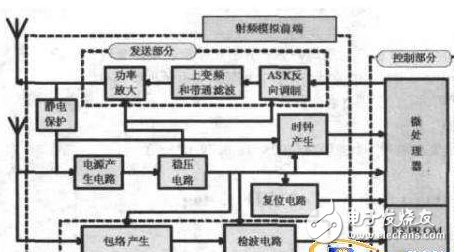RF Front End (RFFE) has been the most important part of mobile phone design since its inception, but it has been ignored. In fact, RF front-end system design is the key to network efficiency and better user experience. This article will talk about what impact he will bring? Let's focus on it.
1. Evolution from LTE to 5G: Improving network efficiency Critical device upgrade considerationsThe evolution of networks to LTE-Advanced (LTE-A) and LTE-Advanced Pro (LTE-A Pro) is an important means of extending the LTE lifecycle and is a key step in ensuring smoothness towards 5G. These technologies not only enable telecom operators to introduce new high-bandwidth services, but also enable them to open new business opportunities, and these upgrades will greatly improve network performance in terms of coverage, cell edge capacity and spectrum efficiency.
Smartphones using these networks will play a decisive role in improving network efficiency. In order to maximize its effectiveness, the RF front-end (RFFE) technology installed in mobile phones is crucial. As a result, the RF front-end architecture not only needs to support 4x4 MIMO, packet tracking (ET), and antenna tuning, but also ensures that all of these are properly integrated into a well-designed modem-antenna design. This article will address the importance of these components in supporting mobile devices in effectively utilizing these network resources.

The evolution of LTE networks is critical to responding to new business cases and increasing network speed, while also providing timely network upgrades to address network capacity and coverage issues. However, technology vendors must also look for ways to improve network efficiency to respond to the massive data demands of the consumer market and provide a better user experience. This method will mainly rely on key parameters such as network coverage, throughput, spectrum efficiency, and network capacity.
MIMO deployments, including 4x4 MIMO and 4x receive diversity, such as 2x4 MIMO, can solve many of these fundamental problems because it provides robustness to wireless links and improves spectral efficiency by using multiple antennas. At the same time, it can achieve higher data transfer rates, greater coverage and higher reliability.
In order to provide a better experience for everyone, many specific components are needed in the device to help with network evolution. Regardless of the impact of modem and battery life, most of these components are related to the RF front end. As these new advanced networks are put into use, each element on the RF front-end chain needs a certain level of upgrade, otherwise it will result in inefficiency and poor user experience.
The choice of antenna technology, power amplifiers (PAs), filters, low noise amplifiers (LNAs) and packet tracking (ET) has become critical in LTE scenarios, especially in LTE-A Pro, as mobile devices are expected to Handling radio frequencies with different propagation parameters. Failure to carefully design a wireless platform to cope with this change will result in overall transmission degradation and system inefficiency.
3. RF design and key component integration are necessary to make full use of network efficiencyIn order to better handle these LTE upgrades and new features brought to the 5G evolution, smartphone design requires some RF front-end mechanisms to take full advantage of the network efficiency achieved by implementing these upgrades, namely: packet tracking (ET), Antenna tuned, 4x4 MIMO RF front-end architecture.
ET is critical because content sharing between consumers is becoming more frequent and the rate of uplinks is also increasing. Reducing the power consumption of RF PAs is a key challenge for smartphone OEMs, which is quickly becoming a major source of power consumption for mobile phones. Compared to average power, ET can increase power efficiency by 30% and has become a must-have component for smartphones that are used efficiently in advanced networks. However, ET currently exists only in high-end smartphones. However, with the advent of upstream carrier aggregation (CA) and high-power user equipment (HPUE) requiring higher transmit power, the demand for rapid penetration of ET into low-end and mid-range handsets is positive. Increasing. ABI Research expects ET to begin a large-scale influx in the mid-end market in mid-2018.
This drive to provide higher power efficiency will also witness the arrival of ET-optimized PA (ET-opTImized PA), which will enable tighter integration between transceivers, ET and PA, resulting in higher bandwidth Higher power efficiency is achieved in the system above. Any increase in the power efficiency of a mobile device not only contributes to battery life, but also directly affects the effective performance of the network from the user's point of view. A mobile device capable of transmitting stronger signals with lower battery current actually increases outdoor and indoor coverage in an uplink limited scenario, such as at the cell edge and indoor VoLTE environment.
Harmonic antennas can significantly reduce the footprint of smartphones because they can be reconfigured to cover a wide range of frequencies and dynamically optimize the link, minimizing wasted transmit/receive power under actual usage conditions. Currently, smartphones have been equipped with multiple antennas to support multi-mode multi-frequency, so adding additional antenna sets is challenging in industrial design and RF optimization. In a very limited environment for smartphones, RF front-end systems need to be carefully designed to optimize the overall performance of the device without compromising the integrity and reliability of the industrial design, both in terms of energy and overall form factor. Reduced interference.
By using the latest adaptive antenna tuning technology, the phone can automatically maximize the quality of the transmit or receive link. This substantially increases the effective throughput as well as the outdoor and indoor coverage of single or multiple carriers. With a 2-6 dB improvement on the link and a dynamic signal-to-noise ratio balance in the CA link, handsets can achieve higher performance on the network. In order to enable mobile phones to support an ever-expanding frequency range, while maintaining power efficiency, antenna tunability will be key to meeting these ongoing needs.
Effective MIMO technology can increase the communication speed in the network by using multiple transceiver antennas, and it is expected to significantly improve signal reliability, network throughput, coverage and spectrum efficiency without using additional transmit power and spectrum resources. Since spectrum bandwidth is an expensive and limited resource, MIMO has become an increasingly important wireless technology in the development of driving more efficient use of available bandwidth. However, these improvements will incur a certain cost, especially in terms of increasing the complexity of smartphone BOM and RF levels, as squeezing MIMO antennas into LTE devices is still not easy.
To make 4x4 MIMO and 2x4 MIMO commercially viable, RF front-end architectures must be optimized for performance, integration, and cost. The RF front-end will continue to be a key subsystem in determining which air interface technology will be feasible in the near future.
As mentioned above, HPUE is a technical supplement that is known to benefit the network by boosting coverage because it can transmit 3 dB more than standard user equipment, which is equivalent to doubling the output power. In addition, since the throughput of LTE is directly related to the transmit power, another benefit of HPUE is the increase in throughput. Implementing HPUE requires an upgrade on the device hardware and therefore requires a PA capable of handling more power generation. In contrast, the network only requires a software upgrade. However, HPUE will eventually have a significant impact on the RF front end because all components on the link, from the transceiver to the PA filter, must support twice the power while maintaining the existing device size and power constraints.
4. Impact of network equipment population and technology mixBy using smartphones in higher-standard LTE networks, users can not only get a better user experience through higher data transfer rates, but these mobile devices will also be more efficient because they require less network resources. Faster speed. This is the technical significance of 4x4 MIMO and 256 QAM, because more bits (information) can be packed in each LTE transmission, that is, they can transmit more bits (information) over the air with a smaller amount of spectrum resources. For example, a high-end Gigabit LTE device can transmit 4 bps per 1 Hz spectrum using a network, while relatively low-end LTE devices transmit about 3 bps on their allocated spectrum.
Much of this increase in efficiency is due to the use of more antennas. On average, one LTE Cat6 smartphone uses two antennas, while a Gigabit LTE device can use three antennas to receive data. In other words, this is the improvement that network efficiency can bring to the 4x4 MIMO technology that does not exist in Cat6 devices.
For mobile operators, having more users on the edge of the network using more efficient (gigabit) LTE smartphones will bring the following benefits:
· Whether you are using these types of mobile phone users, the throughput speed will increase.
Gigabit LTE devices use less network resources to get the speed they need to serve the traffic they generate.
· Regardless of the type of device, an increase in overall capacity will benefit all smartphone users on the network.
For example, for technologies like video streaming, Gigabit LTE and LTE Cat6 smartphone users will get similar throughput quality, but for the same quality video, Gigabit LTE devices use only one-third of the spectrum resources. In an era of unlimited data plan plans, this makes sense for mobile operators eager to upgrade to Gigabit LTE because higher network efficiency can provide more traffic.
In addition, as the speed of mobile phone throughput increases, it will help to deal with “bursty†traffic, such as when receiving Twitter and Facebook upgrades, higher-end phones can use the service faster, and quickly release network resources to other user. Higher speeds also mean that smartphones are starting to get the same read speed as flash on the network, which will help provide a better user experience when accessing cloud services.
Looking ahead, as the market moves further towards 5G NR, HPUE will be critical, especially in the 6 GHz band, as it can increase network uplink coverage by 30%. While ET will play a vital role in reducing power consumption, HPUE is also expected to bring longer battery life. The implementation of HPUE seems to be closely related to ET, so the rapid adoption of ET in low-end and mid-range smartphones will be a basic requirement for significant impact.
Although the adoption of these technologies in smartphones will lead to an increase in network efficiency, OEMs still face many challenges in adopting these technologies, which in turn leads to very few models currently using these technologies on the market. This situation is expected to change in the next 12 months, as more and more smartphone models equipped with these necessary technologies will be introduced, so that they are in line with the introduction of advanced networks, so it will be in network efficiency and A significant improvement in the user experience.
In any case, innovation will not stop, because as the industry evolves toward 5G networks, the use of MIMO will bring additional complexity, and the demand for RF front ends will certainly be further expanded. Massive MIMO, beamforming, and support for additional frequency bands will become essential requirements, creating a whole new set of challenges. In addition, the complexity experienced by the industry will depend on the spectrum environment, as 5G MIMO implementation will depend on the frequency band target, either below 6 GHz or in the millimeter wave band.
The leather mobile Phone cover with the protect function , and you could put the card slots ,it more convient you life .It could fit all phone size , Like S, M and L size (4.7-5.5).We sell Pu/genunine Leather phone case,Card Slot Phone Case,folio Phone Case , Card Slot Back Cover,Leather Mobile Phone Cover,Universal Leather Case.


We employ the most creative designers and tech brilliant engineers to make the best cases. We believe our high-quality products with competitive prices will satisfy your needs.
The productive process :
Make the Products Mould –Cutting the fabric –Do the half products – Finish products – Cleaning –QC- Package – Shippment .
Leather Phone Case,Leather Phone Cover,Leather Mobile Phone Covers,Custom Leather Phone Case Cover
Ysure Leather case 24/7 Support : 86 13430343455 , https://www.ysurecase.com